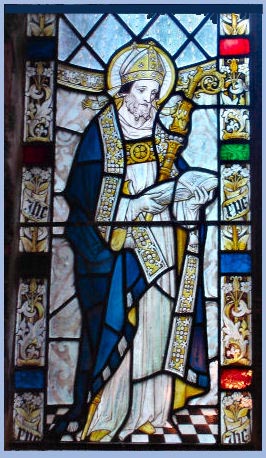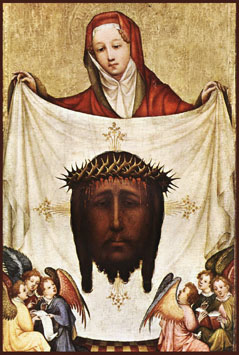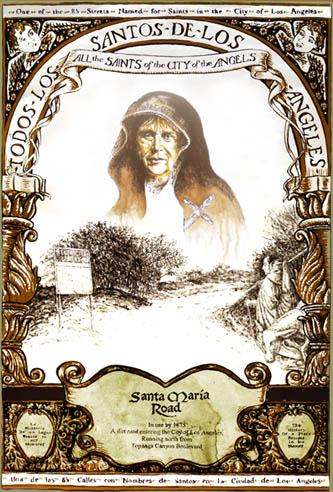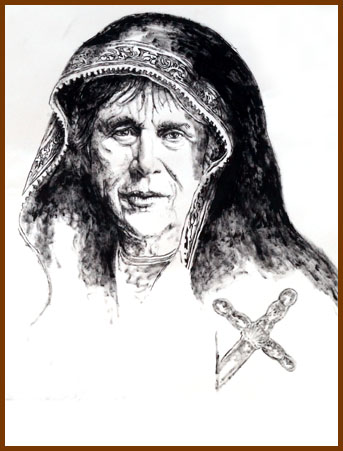
San Jacinto, by J Michael Walker, color pencil/paper
What can I say; I have a particular fondness for San Jacinto, the purple saint. There’s a street bearing his name in the Silver Lake Hills of Los Angeles, north of Sunset and overlooking, intermittently, the silvery lake to the northeast.
It’s a rather sedate drive – apart from the confectionary castle at its mid-point – but, as I wrote in my book (p.65), the street exhibits some mystic tendencies, as it “ambles lightly about the Silver Lake hills, tracing a circumscribed path: Two hundred paces downhill, south by southwest. Turn. Then two hundred paces uphill, north by northeast. Repeat. A sacred Zen dance, good for the heart and legs.”
San Jacinto’s best legends are all, in fact, about ambling lightly.
One I illustrated some years back (at left) recounts how, when the village of Kiev was overrun by “fierce Tartars,” Jacinto grabbed a large, heavy statue of the Virgin Mary and, ‘though she weighed more than he, carried her with no perceptible difficulty to safety.
The legend I treasure more, however, is sometimes confused with this one; perhaps it occurred later on the same journey.
San Jacinto came to the River Dnieper or – what do we know – the River Vistula (Wikipedia informs that the two were once connected) and needed to cross whichever river it was that he, short of boat, needed to cross.
What to do? He crossed the river on foot.
Indeed.
And, it is recorded in the Acta Sanctorum XXXVII, 316, No. 38, that:
“the footprints of the saint remained on the water, even after he had crossed the river; and that, when the stream was calm, they could be seen for centuries afterwards.”
Sigh. Aside from its self-evident zen poetry, three things etch this tale in my heart.
First, when Jacinto was candidate for canonization, the Acta Sanctorum again assures us, “four hundred and eight witnesses were rigidly examined on this very matter, and they all attested on oath that they had seen these footprints with their own eyes; which, they said, the natives of the country call ‘the way of Saint Hyacinth.’ “

The Death of Hyacinthos, by Jean Broc
Second, his English name, Hyacinth, traces back to Apollo’s young lover Hyacinthus, who was killed in rivalry with Zephyrus: Hyacinthus’ spilled blood, which Apollo gathered, legendarily formed the liquid seed for the Hyacinthus orientalis (Interestingly, Wiki also informs us that “Hyacinths are sometimes associated with rebirth”).
But, for the water hyacinth, I cannot help but presume that the name derives from the legend of San Jacinto, for the plant is a tenacious free-floating perennial, remaining on the surface of any waterway to which it is introduced despite ‘most any efforts at extermination or control.
San Jacinto demonstrated this self-same tenacity for me the first year of All the Saints, when I created large prints of the Eastside Los Angeles saint-streets, and installed them in city bus shelters. San Jacinto Street had been among this first batch, and I had focused on his watery legend in my portrayal.
My friend Sally Stein and I went around to photograph each of the bus shelter installations. When we came to the San Jacinto Street installation at, as I recall, Sunset and Fountain, Sally remarked that she was surprised she wan’t seeing any light reflected on the glass covering my piece – only then did we realize that the glass had been utterly broken and lay all over the cement, and that someone had pulled hard on my print to remove it, but to no avail:
San Jacinto had held on, steadfast even in the L.A. night.

San Jacinto Street, photographed by J Michael Walker, festooned with zempasuchil flowers, the eve of All Saints Day, L.A. 2000



 Today’s issue of the New York Times Travel section has a
Today’s issue of the New York Times Travel section has a 














